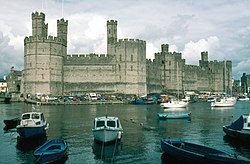Caernarfon
| Caernarfon | |
| Caernarfonshire | |
|---|---|
 Caernarfon Castle | |
| Location | |
| Grid reference: | SH485625 |
| Location: | 53°8’24"N, 4°16’12"W |
| Data | |
| Population: | 9,611 |
| Post town: | Caernarfon |
| Postcode: | LL55 |
| Dialling code: | 01286 |
| Local Government | |
| Council: | Gwynedd |
| Parliamentary constituency: |
Arfon |
Caernarfon, the county town of Caernarfonshire is a historic royal borough on the Menai Strait, at the mouth of the River Seiont.
Caernarfon is renowned for and dominated by Caernarfon Castle. This great stone castle built by King Edward I of England stands on the shore, one of the most complete mediæval castles in Britain. Castle Square is the town's focal point. Castle Square was refurbished in 2009.
Away from the square, narrow street wander up into a busy town. Much of the town is given over to tourism, but as the major town of Caernarfonshire it is a centre in its own right.
Caernarfon has a small harbour, and a beach (at Victoria Harbour). The location of the town creates a lovely view across the Menai Strait towards the south of Anglesey.
Caernarfon is also home to the regimental museum of the Royal Welch Fusiliers.

Name

The town’s name is may be written “Caernarfon” or in anglicised forms, Caernarvon or Carnarvon, though the former, the Welsh spelling, is now most usual.
The Roman name for the place was Segontium, a reflection of the river on which it stands. Caernarfon derives its name from the Roman fortifications. In Welsh, the place was called "y gaer yn Arfon", meaning "the stronghold in the land over against Môn"; Môn being the Welsh name of the island of Anglesey.
A charter of 1221 granted by Llywelyn the Great to the canons of Penmon priory, in Anglesey, refers to Kaerinarfon,[1], and Brut y Tywysogion uses the forms Kaerenarvon and Caerenarvon.[2]
An early alternative name was Caer Seiont; the mediæval Welsh tale Breuddwyd Macsen ("Macsen's Dream", found in the Mabinogion) calls it Caer Aber Sei(o)n(t) ("the fort on the estuary of the River Seiont"). The town was also known as Caer Gystennin ("The Castle of Constantin").[3]

Architecture
One of the oldest buildings in the town is The Market Hall, which is situated on Hole In The Wall Street.
The grand old court buildings, though replaced in 2009 by a new complex in Llanberis Road, stand within the castle walls. The Magistrate Court was built in the gothic style of decoration making for an imposing building. The old buildings adjoin Caernarfon Gaol, which closed in the early 20th century.
Caernarfon Castle
Caernarfon Castle was built by Edward I of England to secure his domination of north Wales. Edward's architect, James of St. George, may well have modelled the castle on the walls of Constantinople, to which they bear striking resemblance, possibly being aware of the town's alternative Welsh name Caer Gystennin.
The castle remains intact, as it has never suffered a sustained attack.
History
On higher ground on the outskirts of the town are the remains of an earlier occupation, the Segontium Roman Fort.
Caernarfon was constituted a borough in 1284 by charter of Edward I and has been confirmed on a number of occasions. The charter appointed the Constable of the Castle as the mayor of the borough by virtue of the office.[4]
In 1955 Caernarfon was in the running for the title of "Capital of Wales" on historical grounds. However the town's campaign was heavily defeated in a ballot of Welsh local authorities, with 11 votes compared to Cardiff's 136. Cardiff therefore became Wales's first official capital city.
Investitures
In 1911, David Lloyd George, then Member of Parliament for Caernarfon Boroughs, agreed to the Royal Family's idea of holding the investiture of the new Prince of Wales at Caernarfon Castle. The ceremony took place on 13 July 1911, with the royal family present. The future King Edward VIII was duly invested as Prince.
On 1 July 1969 the investiture ceremony was again held at Caernarfon Castle, the recipient on this occasion being Charles, Prince of Wales. The ceremony itself went ahead without incident despite nationalist threats and protests.
Culture
Demographically the population of Caernarfon is the most Welsh-speaking community in all of Wales; 86.1% of the population could speak the Welsh language in the 2001 census, with the largest concentration of Welsh speakers in the 10-14 age group, where 97.7% could speak it fluently. The town is nowadays a rallying-point for the Welsh nationalist cause.
Caernarfon hosted the Royal National Eisteddfod of Wales in 1862, 1894, 1906, 1921, 1935, 1959 and 1979. Unofficial National Eisteddfod events were also held there in 1877 and 1880.
References
- ↑ [1]
- ↑ Thomas Jones (ed.) Brut y Tywysogion[:] Peniarth MS. 20 (Cardiff, 1941), though mediæval orthography was inconsistent even within the same manuscript text. Kaerinarfon, Kaerenarvon and Caerenarvon correspond to Caer-yn-Arfon in modern Welsh orthography. The letter "y" would naturally be lost in the spoken language, thus giving the standard Welsh name Caernarfon ("Caer 'n Arfon").
- ↑ See Sir Ifor Williams' notes in his edition of Breuddwyd Maxen (Bangor, 1920). The name appears for the first time in the work of Nennius. Pre-conquest mediæval Welsh poets such as Hywel ab Owain Gwynedd sometimes use the name Caer Gystennin.
- ↑ The Town Charter, Caernarfon Royal Town Council, accessed October 21, 2007